Hedge Plants For Protecting Gardens
Hedge Plants For Protecting Gardens
Blog Article
Hedge Plants For Beautiful Borders
Boost your garden's attraction with lush hedge ranges such as Yew (Taxus), Thuja, Laurel, Photinia, and Bamboo, celebrated for their structural stability and ecological advantages.
Yew and Thuja offer evergreen protection and winter durability, while Laurel uses rapid development and broad, aromatic leaves.
Photinia adds seasonal appeal with its lively red foliage, and Bamboo lends a low-maintenance, tranquil ambiance.
These hedges improve air quality, reduce noise, and produce tranquil, private spaces.
Appropriate planting, spacing, and upkeep ensure energetic growth and environmental harmony.
Explore how these rich ranges can raise your garden's appeal and well-being.
Key Takeaways
Change Your Garden With Lush Hedge Varieties
- Select Yew for its thick, evergreen development and unparalleled longevity.
- Select Laurel for its quick development and broad leaves, ensuring fast personal privacy.
- Pick Photinia for its dynamic seasonal foliage, which turns a striking dark red.
- Make use of Bamboo for a low-maintenance, winter-hardy hedge with visual appeal.
- Area plants 2-3 per meter and prune frequently for optimal growth and health.
Popular Hedge Plants
When transforming a garden with lush hedge varieties, it's important to think about popular hedge plants such as Yew, Thuja, Laurel, and Photinia due to their special attributes and advantages.
Yew (Taxus) is extremely respected for its durability and thick, green development, making it a prime option for sustaining landscapes.
Thuja is kept in mind for its evergreen foliage and robust winter season durability.
Photinia adds seasonal vibrancy with red leaves that darken in time, producing dynamic visual appeal.
Laurel offers quick development and aromatic, broad leaves, suitable for quick privacy.
Additionally, Bamboo is an excellent option for atmosphere, providing a low-maintenance, winter-hardy option that enhances the garden's visual with its classy, swaying walking sticks.
These selections cater to a range of horticultural requirements and preferences.
Advantages of Garden Hedges
Garden hedges provide a wide range of benefits, making them an important addition to any landscape. These natural barriers are economical to execute and supply significant wind defense, boosting air blood circulation and contributing to noise reduction. The thick foliage of hedges like Thuja and Beech makes sure personal privacy by obstructing exposure, creating a secluded and serene environment.
Hedges likewise play a crucial function in microclimate regulation, supplying a stable environment that cultivates plant growth and minimizes temperature level variations. Their complex leaf structures filter pollutants, improving air quality and adding to a healthier garden environment.
Furthermore, hedges stand out in sound reduction, taking in and deflecting sound waves to lower ambient noise levels. This double functionality of providing both acoustic and visual personal privacy enhances the general tranquility and visual appeal of any garden.
Planting and Maintenance Tips
For a successful hedge, meticulous preparation of the planting location is vital. Guarantee the soil has appropriate pH and drain to support strong root advancement.
Area the plants properly for the chosen types. Water the hedge often throughout its initial development stage, adjusting as needed with seasonal modifications.
Carry out a methodical bug control and illness prevention technique, utilizing chemical or natural treatments when necessary. Frequently inspect for aphids, mites, and fungal infections.
Apply mulch to keep wetness and reduce weeds. Seasonal pruning promotes dense growth and air flow, necessary for plant health.
Following these guidelines will assist you cultivate a lively, properly maintained hedge that boosts the beauty of your garden.
Spacing and Trimming Guidelines
Spacing and Cutting Standards
Correct spacing and cutting are vital for cultivating healthy, aesthetically appealing hedges. Appropriate spacing makes sure each plant gets enough nutrients, light, and air flow.
Follow these standards for ideal hedge upkeep:
- Spacing: Position hedge plants 2-3 plants per meter to motivate robust development.
- Pruning Methods: Routine pruning is vital for preserving desired hedge height and shape. Cut brand-new development in summertime and cut back older wood throughout winter season.
- Seasonal Care: Adjust trimming schedules and techniques according to seasonal requirements to ensure plant health.
- Hedge Height: Regularly display and cut to maintain the desired hedge height and attain uniform visual appeals.
Abiding by these steps will ensure your hedge thrives, boosting both the appeal and performance of your garden.
Choosing the Right Hedge
Picking the Right Hedge
Choosing the proper hedge includes assessing factors such as fully grown height, foliage density, and environmental strength. Successful hedge plant selection requires comprehending each types' growth attributes and site-specific versatility.
For example, Yew (Taxus) offers exceptional durability and dense development, while Thuja is notable for its winter season resilience. Furthermore, considering upkeep requirements is essential; fast-growing types like Laurel or Privet demand routine trimming, whereas low-maintenance alternatives like Bamboo or Ivy might be preferable for those looking for minimal upkeep.
Ecological elements such as soil type, light schedule, and moisture conditions must likewise direct the choice process. This cautious approach guarantees the selected hedges will thrive, offering both functional and visual benefits to the garden landscape.
Shipment and Planting Recommendations
To guarantee your hedge plants flourish, they need to be delivered by specialized carriers and planted quickly upon arrival.
Follow these essential steps for effective planting:
- Soil Preparation: Improve the soil with raw material to enhance drain and nutrient content.
- Planting Depth: Produce a trench twice the width and equal to the depth of the root ball.
- Watering Strategies: Water completely after planting, keeping the soil consistently damp however not filled.
- Mulching: Use a layer of mulch to retain moisture and suppress weeds.
Client Assistance and Service
Offered the essential function of prompt assistance in horticultural pursuits, our client assistance group is readily available six days a week through telephone, email, and social media to provide expert advice and quickly attend to any issues. Their devotion to fast reaction times makes sure consumer satisfaction by fixing questions related to plant health, optimal planting methods, and maintenance schedules.

----------------------
This comprehensive support group, strengthened by an excellent 9.3/ 10 customer rating, highlights our commitment to improving the gardening experience for each customer.
Regularly Asked Concerns
The Length Of Time Does It Take for Hedge Plants to Establish?
Hedge plants typically need one to 3 years to end up being fully established, with the precise period varying by species and growing conditions.
Efficient care during this vital duration is vital for robust growth. Consistent watering, watchful weed control, and appropriate fertilizer application are pivotal in promoting strong root development.
For example, fast-growing species like Laurel may establish quicker, while slower-growing ranges such as Yew may take longer. Thorough upkeep accelerates the establishment process, leading to healthy and thick hedges.
What Are the Best Hedge Plants for Privacy?
The concern of the finest hedge plants for privacy involves evaluating evergreen and deciduous alternatives.
Evergreen hedges like Thuja, Laurel, and Cypress supply year-round coverage, ensuring continuous personal privacy.
On the other hand, deciduous hedges such as Beech offer seasonal privacy, shedding leaves in cooler months.
Key maintenance pointers for privacy hedges include routine trimming, fertilizing in spring, and proper spacing-- normally 2 to 3 plants per meter.
Furthermore, consistent watering and thorough weed removal are crucial for promoting healthy, thick growth.
Can Hedge Plants Attract Wildlife to My Garden?
Yes, hedge plants can draw in wildlife to your garden by providing essential advantages like shelter, food, and nesting sites, therefore improving local biodiversity. For circumstances, yew, holly, and laurel are outstanding for attracting birds, while ivy supports a range of insects.
Nevertheless, it's important to keep in mind that there are some disadvantages, such as increased upkeep to manage pests and routine upkeep. Thoroughly choosing and keeping hedge varieties can assist balance these downsides and benefits, ultimately fostering a sustainable and dynamic community in your garden.
Exist Any Blooming Hedge Plants Available?
Yes, there are flowering hedge plants available that can improve the appeal of your garden.
For example, Elaeagnus, likewise referred to as Olive Willow, produces aromatic white flowers in the fall, adding a touch of beauty.
Photinia, another popular option, showcases vibrant red leaves that develop into an abundant green, producing a vibrant visual result throughout the seasons.
To ensure these plants flourish, it's necessary to practice proper pruning techniques and seasonal maintenance, such as cutting brand-new development in the summer and cutting back in the winter.
These steps will assist keep the health and visual appeal of your blooming hedges.
How Do I Avoid Pests in My Hedge Plants?
To prevent bugs in hedge plants, employ natural pest control methods and maintain proper hedge care. Introduce useful pests like ladybugs, which victimize damaging bugs, to develop a well balanced environment.
Frequently check your hedges for indications of problem and without delay get rid of any afflicted parts to prevent the spread. Guarantee the health of your hedges by using balanced fertilizers and offering adequate water.
Utilize mulching to retain soil wetness and correct spacing to minimize plant tension and promote robust growth. These practices collectively assist in decreasing bug problems and maintaining a healthy hedge.
Conclusion
In essence, choosing the right hedge ranges such as Yew, Thuja, and Laurel can transform any garden into a peaceful haven. These plants supply year-round plant, enhance visual appeal, and deal practical benefits like noise reduction and wind defense.
Correct planting methods, accurate spacing, constant watering, and seasonal trimming are vital for optimum growth.
Reputable delivery services and skilled client assistance guarantee a seamless experience from purchase to planting, making it easier than ever to elevate your outside space.
Garden hedges use a wide Browse around this site variety of advantages, making them an important addition to any landscape. These natural barriers are affordable to carry out and offer substantial wind security, enhancing air circulation and contributing to sound reduction. The thick foliage of hedges like Thuja and Beech ensures personal privacy by obstructing presence, producing a serene and remote environment.

Pruning Methods: Regular pruning is essential for keeping preferred hedge height and shape. Trim brand-new development in summertime and cut back older wood during winter season.
Report this page